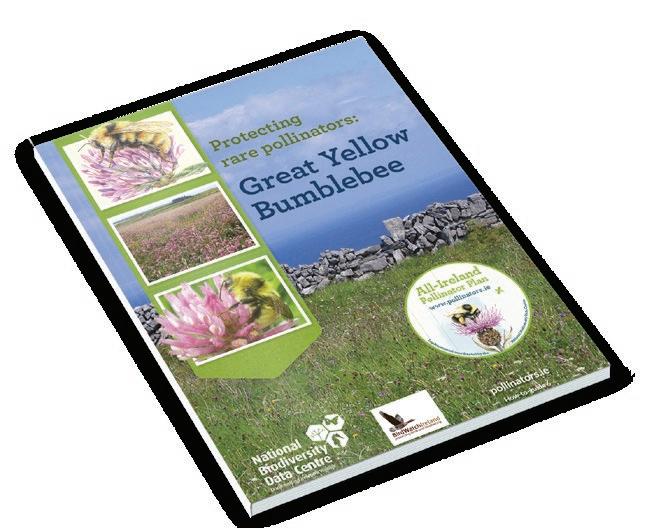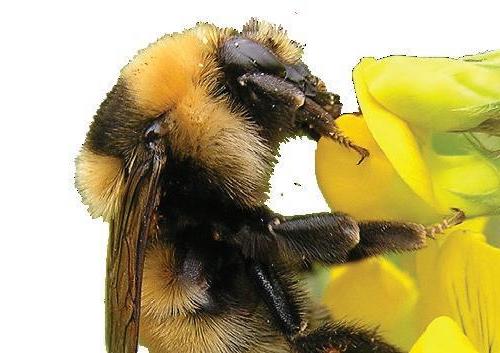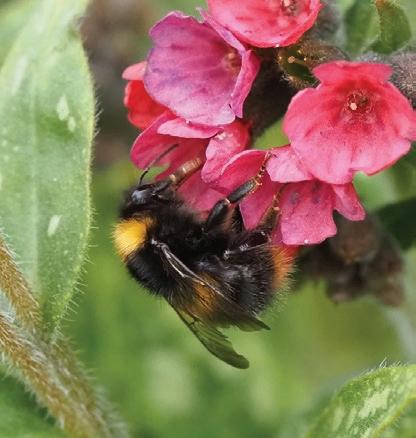
3 minute read
Objective 05 Conserving rare pollinators
OBJECTIVE 05
Conserving rare pollinators
Advertisement
Targets for 2021–2025:
TARGET 5.1 Ensure rare pollinators are protected by legislation where appropriate
TARGET 5.2 Raise awareness of rare pollinators
TARGET 5.3 Publish best practice information on protecting rare pollinators
TARGET 5.4 Publish and update All-Ireland conservation assessments for pollinating groups (Red Lists)
TARGET 5.5 Track change in rare pollinators
Target 5.1
5.1 Action
131 Protect rare pollinators through the Wildlife Act in RoI when warranted.
Progress measure
Species added to Schedule 5 of Wildlife Act
132 Ensure rare pollinators are protected by legislation in NI where appropriate. Included on Priority Species list, under The Wildlife and
Natural Environment Act Northern Ireland Environment Agency (NIEA), Centre for Environmental Data and Recording NI (CEDaR)
Responsibility
National Parks and Wildlife Service (NPWS)
Target 5.2
Raise awareness of rare pollinators
5.2 Action
133 Work to develop initiatives to assist recovery of the endangered Great Yellow Bumblebee (Bombus distinguendus).
Progress measure
Guideline document (Protecting rare pollinators: Great Yellow
Bumblebee, 2019) promoted and distributed to all relevant stakeholders Awareness raising within local communities in remaining
Great Yellow Bumblebee strongholds (Mullet Peninsula,
Mayo) Development of a species recovery plan for the Great Yellow
Bumblebee Continued management of BirdWatch Ireland reserves in the Mullet Peninsula to also support the Great Yellow
Bumblebee. Investigation into funding mechanisms to increase the area of land that is managed to support the Great Yellow
Bumblebee. National Biodiversity Data Centre, NPWS, BirdWatch Ireland, Mayo County Council, Belmullet Tidy Towns, University College Dublin (UCD)
Responsibility
5.2 Action
134 Work to develop initiatives to assist recovery of the near threatened Large Carder Bee (Bombus muscorum).
Progress measure
Continue to monitor its status - data from the All-Ireland
Bumblebee Monitoring Scheme (2012-2019) shows an ongoing decline. Identify a network of key locations where healthy populations remain Work with local authorities and local communities to raise awareness of the Large Carder bee in these areas and to encourage pollinator-friendly actions to support it AIPP team in collaboration with relevant partners
135 Develop resources on rare pollinators and make freely available. As resources are developed, all collated and added to the website: https://pollinators.ie/helping-endangeredpollinators/ AIPP team in collaboration with relevant partners
136 Promote rare pollinator species through social media campaigns. Social media campaign to raise awareness on the status, identification, and ecology of one rare pollinator species each year Great Yellow Bumblebee, Large Carder Bee and Northern
Colletes bee to be prioritised initially. Others to be finalised in future years.
Responsibility
AIPP team in collaboration with relevant partners
Target 5.3
5.3 Action
137 Publish how-to-guides on protecting rare pollinator species.
Progress measure
New species-specific guides published within the AIPP
Protecting rare pollinators series when a sufficient evidencebase is available.
Responsibility
AIPP team in collaboration with relevant partners
Target 5.4
5.4 Action
138 Publish an All-Ireland Hoverfly Red List.
139 Develop a roadmap towards updating the AllIreland Bee Red List (2006).
Progress measure
Publication of an All-Ireland Red List outlining the conservation status of Ireland’s hoverfly species.
Publication of an updated checklist of Irish Bees Development of a roadmap outlining necessary data collection that would allow updating of the 2006 Bee Red
List. NPWS, NIEA, National Biodiversity Data Centre, CEDaR
Responsibility
NPWS, NIEA
Target 5.5
Track change in rare pollinators
5.5 Action
140 Conduct dedicated surveys to establish the status and distribution of the Northern Colletes bee and the Redshanked Carder bee in NI.
Progress measure
NIEA to investigate whether surveys could be delivered through grant funding by partner organisations, e.g. Buglife Surveys successfully completed. NIEA and funded partners
Responsibility
141 Attempt to increase the number of volunteers tracking rare species within the AllIreland Bumblebee Monitoring scheme.
142 Organise field meetings with volunteer recording networks to search for rare species. Pending resources, identification workshops on the following rare bumblebee species, run in areas where they occur: Great Yellow Bumblebee, Shrill Carder Bee, Mountain
Bumblebee Attempts made to encourage Citizen Science volunteers to walk specific routes to monitor these rare bumblebees. National Biodiversity Data Centre
Rare species hunts organised in appropriate areas, where funding allows. This will have to be limited to species that can be easily identified in the field. National Biodiversity Data Centre, CEDaR, BugLife
Protecting rare pollinators: Great Yellow Bumblebee guide Great Yellow Bumblebee, Bombus distinguendus © Steven Falk













